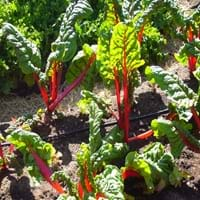Life Span
Perennial
Biennial or Perennial
Type
Bulb or Corm or Tuber
Vegetable
Origin
South America, Argentina
Europe
Types
Not Available
Leaf beet, Seakettle beet, Spinach beet
Habitat
Temperate Regions
Cultivated Beds
USDA Hardiness Zone
5-9
4-8
Sunset Zone
21,22
A1, A2, A3, H1, H2, 1a, 1b, 2a, 2b, 3a, 3b, 4, 5, 6, 7, 8, 9, 10, 11, 12, 13, 14, 15, 16, 17, 18, 19, 20, 21, 22, 23, 24
Habit
Clump-Forming
Clump-Forming
Flower Color
Light Blue, Light Purple, Silver, Sky Blue
Red, Green
Flower Color Modifier
Bicolor
Bicolor
Fruit Color
Not Available
Tan
Leaf Color in Spring
Green, Light Green, Gray Green
Dark Green, Green, Orange, Red, White, Yellow
Leaf Color in Summer
Light Green
White, Yellow, Red, Green, Orange, Dark Green
Leaf Color in Fall
Several shades of Green
White, Yellow, Red, Green, Orange, Dark Green
Leaf Color in Winter
Light Green
Not Available
Leaf Shape
Grass like
Heart-shaped
Plant Season
Spring
Spring, Summer, Fall, Winter
Sunlight
Full Sun, Partial Sun, Partial shade
Full Sun
Type of Soil
Clay, Loam, Sand
Loam, Sand
The pH of Soil
Acidic, Neutral, Alkaline
Neutral, Alkaline
Soil Drainage
Well drained
Well drained
Bloom Time
Early Spring, Spring, Late Winter
Late Spring, Early Summer, Summer
Tolerances
Drought
Drought
Where to Plant?
Container, Ground
Ground
How to Plant?
By dividing rhizomes, tubers
Seedlings
Plant Maintenance
Medium
Medium
Watering Requirements
Average Water Needs, Do Not over Water, Requires regular watering
Average Water Needs
In Summer
Lots of watering
Lots of watering
In Spring
Moderate
Moderate
In Winter
Average Water
Average Water
Soil pH
Acidic, Neutral, Alkaline
Neutral, Alkaline
Soil Type
Clay, Loam, Sand
Loam, Sand
Soil Drainage Capacity
Well drained
Well drained
Sun Exposure
Full Sun, Partial Sun, Partial shade
Full Sun
Pruning
Remove damaged leaves, Remove dead branches, Remove dead leaves
Remove damaged leaves, Remove dead branches, Remove dead leaves
Fertilizers
All-Purpose Liquid Fertilizer
Apply 10-10-10 amount
Pests and Diseases
Slugs, Snails
Cercospora leaf spot, Damping off, Darkling beetles, Downy mildew
Plant Tolerance
Drought
Drought
Flowers
Showy
Insignificant
Flower Petal Number
Single
Not Available
Foliage Texture
Medium
Coarse
Foliage Sheen
Matte
Glossy
Attracts
Bees, Birds, Hummingbirds
Insects
Allergy
Not Available
dark circles, Diarrhea, Runny nose, Vomiting, wheezing
Aesthetic Uses
Showy Purposes
Ground Cover
Beauty Benefits
Not Available
Moisturizing, Remove blemishes, Slow downs aging, Speed hair growth
Environmental Uses
Air purification
Air purification
Medicinal Uses
No Medicinal Use
Antitumor, Carminative, Haemostatic, Stomachic, Tonic
Part of Plant Used
Flowers
Leaves, Root
Other Uses
Not Available
Cultivated for fodder, Eaten as a pot herb, Used to make juice
Used As Indoor Plant
Yes
No
Used As Outdoor Plant
Yes
Yes
Garden Design
Container, Lawns and Turf, Mixed Border, Rock Garden / Wall, Wildflower
Bedding Plant, Container, Edible, Herb / Vegetable, Mixed Border
Botanical Name
Ipheion uniflorum
BETA vulgaris ssp. cicla
Common Name
Spring Starflower, Springstar
Swiss Chard
In Hindi
Spring Starflower
Swiss Chard
In German
Frühling Borretsch
Swiss Chard
In French
Spring Starflower
Chard suisse
In Spanish
primavera Flor de estrella
Acelgas
In Greek
άνοιξη starflower
Σέσκουλο
In Portuguese
primavera Starflower
Acelga suíça
In Polish
Wiosna Starflower
Boćwina
In Latin
Spring Starflower
Swiss Chard
Phylum
Magnoliophyta
Magnoliophyta
Class
Lilopsida
Magnoliopsida
Order
Asparagales
Caryophyllales
Family
Liliaceae
Chenopodiaceae
Clade
Angiosperms, Monocots
Angiosperms, Core eudicots, Eudicots
Tribe
Gilliesieae
Cyclolobeae
Subfamily
Allioideae
Betoideae
Number of Species
Not Available
Season and Care of Spring Starflower and Swiss Chard
Season and care of Spring Starflower and Swiss Chard is important to know. While considering everything about Spring Starflower and Swiss Chard Care, growing season is an essential factor. Spring Starflower season is Spring and Swiss Chard season is Spring. The type of soil for Spring Starflower is Clay, Loam, Sand and for Swiss Chard is Loam, Sand while the PH of soil for Spring Starflower is Acidic, Neutral, Alkaline and for Swiss Chard is Neutral, Alkaline.
Spring Starflower and Swiss Chard Physical Information
Spring Starflower and Swiss Chard physical information is very important for comparison. Spring Starflower height is 10.20 cm and width 5.10 cm whereas Swiss Chard height is 30.00 cm and width 30.50 cm. The color specification of Spring Starflower and Swiss Chard are as follows:
Spring Starflower flower color: Light Blue, Light Purple, Silver and Sky Blue
Spring Starflower leaf color: Green, Light Green and Gray Green
Swiss Chard flower color: Red and Green
- Swiss Chard leaf color: Dark Green, Green, Orange, Red, White and Yellow
Care of Spring Starflower and Swiss Chard
Care of Spring Starflower and Swiss Chard include pruning, fertilizers, watering etc. Spring Starflower pruning is done Remove damaged leaves, Remove dead branches and Remove dead leaves and Swiss Chard pruning is done Remove damaged leaves, Remove dead branches and Remove dead leaves. In summer Spring Starflower needs Lots of watering and in winter, it needs Average Water. Whereas, in summer Swiss Chard needs Lots of watering and in winter, it needs Average Water.





